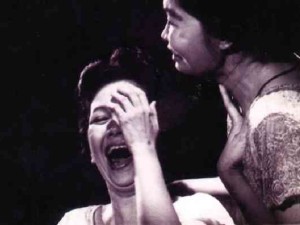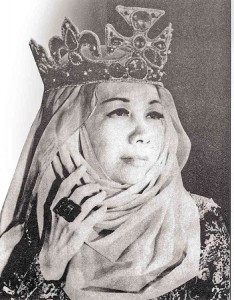
‘Okay, I’m nuts!’ When she was about to play Mary Tyrone, the drug-addled mother of a dysfunctional family in Eugene O’Neill’s “Long Day’s Journey into Night,” Daisy Avellana went to a well-known doctor to research on drug addiction. She needed guidance on how an addict—a woman at that—moved, thought and comported herself.
Her visit to the doctor was duly noted by Manila’s insular society, and word quickly went around that the eminent Daisy Hontiveros Avellana, muse and wife of the equally celebrated film and theater director Lamberto Avellana, had become unhinged.
“Nabuang daw ako,” said Avellana, chortling. “They said, Ay, Daisy’s gone nuts! So I said, OK, I’m nuts! And that really went around, you know.”
No small roles
“[English teacher and drama coach] Jean Edades gave me the best lesson in humility. At that time, I was already the star of all the plays in UP. And then, when we were putting up these three one-act plays, she said I was going to play the role of a maid! I was hurt, of course, and humiliated. I told Mrs. Edades I had a headache and went home. I told my parents about it, expecting them to side with me. But my parents [Supreme Court Justice José Hontiveros and Vicenta Pardo] instead scolded me! They said, go back, apologize, and play the role. So I did. Afterwards, her theater friends told Mrs. Edades: ‘You have very good actors in your group, but that young girl who played the maid, she’s going to be a star!’”
“I’ve never forgotten what Mrs. Edades told me. ‘There are no small roles, only small actors.’ That’s a lesson I keep telling the young ones. Even in life, it’s the same thing. There are no small roles in life, only small people.”
Theater as a ray of hope

“The period between 1942 and 1945 might well have been the beginning of our Golden Age in Philippine theater. The Japanese had banned the showing of foreign films and shut down local movie productions… Enterprising drama groups, the Barangay Theater Guild included, seized the opportunity. We sought permission to stage our productions in the now-vacant movie houses.
“It was a joy to see the SRO sign for practically all the plays presented… You went for two hours to forget that there was a war going on outside, that there were people getting tortured and killed. We provided that hope. It was something.”
The Filipino audience
“The Filipino audience is like the little girl in the nursery rhyme: ‘When she is good, she is very, very good; when she is bad, she is horrid.’ One can never accuse such an audience of being indifferent. It’s either they love you, or they boo you. Sometimes the Filipino spectator may comment out loud on the play, but at least the actors know that the audience is following the presentation and is interested. You might call this audience participation to the nth degree. And this feeling of being part of the show holds true in all Filipino audiences, whether it be composed of children, college students, or older people.
“The only thing wrong with the Filipino audience is that there isn’t enough of it.”
On humility and dedication
“You must learn to be humble, to accept defeats and triumphs because it builds you up as a person… If you love something, you stay with it. Ke me pera, ke walang pera. During my time, we did it because we loved to do it.”
(Her work on the movie version of “A Portrait of the Artist as Filipino” was the first time she was paid for her acting. This was already 1965, some 30 years after she had begun her career as an actress. “Before this, it was all gratis and plenty of amore. But it was worth it.”)
Her legacy, and how she wants to be remembered
“That’s for others to say. I just hope to be remembered as a good human being. And that I loved the theater and I tried my best. I was not always great, but I did my best. Whether I triumphed in my roles or not, it’s important that I did my best.”
The dream of a national theater
“Right now the question of what language to use for the plays is not important. What is important is that every production put on by the amateur groups and the school groups is just one more little step forward towards the realization of a dream: the dream of a national theater.
“New drama groups are regularly being formed; some groups will fall by the wayside, others go on; the youngest one hopefully announced its plans only a few days ago. More groups will continue to be formed, because our young colleagues have learned, like us, that once the magic of the theater touches you, you are enchanted forever.
“And when the time does come for the Filipino national theater to emerge and to take its place at center stage, we who were young… may no longer be on the scene, but we shall be watching, in spirit, from the wings.”









































